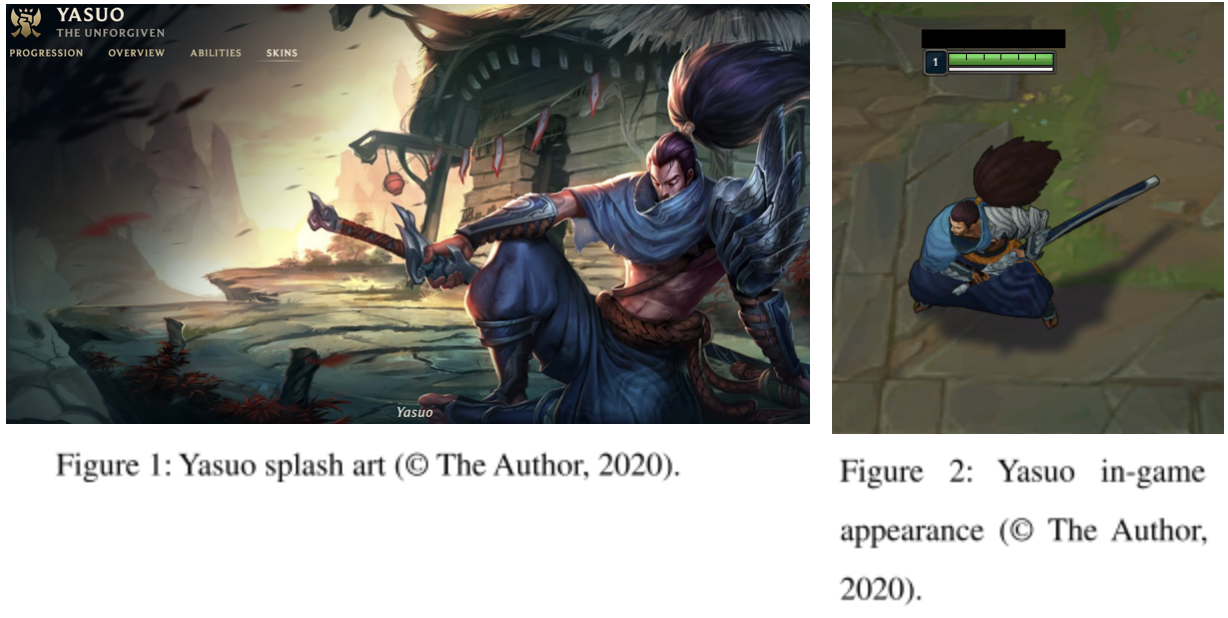FIRST EDITION
Lauren Bergin
“I Will Not Die Dishonoured”: Popular Conception of Samurai Warfare in the Online Video Game League of Legends.
Abstract
In a world where the virtual realm dictates our knowledge of history, it is essential to understand the power of video games in public conceptions of historical warfare. Using the case of the samurai warrior Yasuo from the online game League of Legends, I have shown that despite the game’s fantastical nature the character design is influenced by historical facts. Yasuo’s character exhibits several hallmarks of the original Japanese samurai, specifically in his weaponry and his ability toolkit. I therefore argue that Yasuo presents a different but by no means inaccurate portrayal of bushidō warfare.
Keywords: Strategy; Video Games; Popular Culture; Military History.
Described by developers Riot Games as a “team-based strategy game where two teams of powerful champions face off to destroy the other’s base”, League of Legends (LoL) has come to dominate the online gaming scene (Riot Games, 2020). With Riot boasting an impressive 8 million players a day, LoL has influenced the lives and conceptions of gamers across the globe (Goslin, 2020). Based in a fantasy world where mages run free and a giant crocodile has a jackal as a brother, it can be questioned as to whether or not there is any educational value to the game. While the game itself should hardly be taken as historical fact, the concepts that underpin certain characters contain kernels of historical truth. Taking the samurai warrior Yasuo as my case study, I will argue in this article that his weaponry, in-game abilities and combat methods are historically sound in their portrayal of bushidō warfare. I have elected Yasuo as my case study as he is currently the fourth highest played champion in the game out of 148 options, making him an incredibly popular and, in turn, influential pick (Tierlist, 2020). To begin I will explain the meaning of bushidō and its relation to samurai warfare, before going on to integrate this into my study of Yasuo’s historical value.
In his 1716 text the Hagakure, contemporary samurai Yamamoto Tsunetomo writes that bushidō is the warrior code of the samurai and the rules that they were taught to abide by. At its core, however, is that the “way of the warrior is fulfilled in death”, meaning that one should be willing to die or live dishonoured (2002: 3-4). The bushidō mindset came to dominate Japanese military thought, rearing its head as recently as World War II. With historian Albert Axell stating that the 7,000 kamikaze pilots who sacrificed themselves towards the close of the war did so under the notion that they would ‘continue to live with the living and the dead’, bushidō culture clearly maintains a place in Japanese military society (2002: 2). It is these fierce fighters that have become heavily popularised in Western media, with films such as The Last Samurai continuing to promote bushidō-style ideals. It is therefore no surprise that LoL, a game which has assimilated different conflict styles from across history, has chosen to integrate bushidō warfare into its virtual world in the form of Yasuo. Framed for murdering his master, Yasuo exists as a lone wolf, travelling in search of a purpose wielding only the katana that became so synonymous with his infamy (Riot Games, 2020).
It is this sword that the player is drawn to when playing Yasuo. Featuring prominently in both the champion’s splash art (Figure 1) and in-game appearance (Figure 2), the sword’s design is heavily influenced by that of the Japanese katana. Described by historian Stephen Turnbull as “the finest edged weapon in world military history”, the katana is characterised by its curved blade and deadly appearance (2011: 4). It was at the heart of the samurai way of war, with philosopher Jesús Ilundáin-Agurruza citing one swordsman as saying that “when I am polishing a sword… I am polishing my soul” (2014: 464). The katana was more than a weapon. It was the core component of a ritual-based military lifestyle that the samurai practiced, therefore its inclusion in Yasuo’s character design adds historical authenticity to LoL’s portrayal of the bushidō warrior. Yet, it is not only his sword that is accurately represented, but the way in which his abilities perform around it.

While some elements of Yasuo’s combat abilities are more fantastical in nature, the katana lies at the heart of Yasuo’s fighting style. However, its offensive utilisation is particularly risky. His ‘Steel Tempest’ requires the player to be in close proximity to the enemy champion, and his ‘Sweeping Blade’ hurtles him towards the enemy, often landing them in the middle of team fights (League of Legends, 2020). Just as the samurai were forced to choose between life and death in an instant, the player has to make game changing decisions every time they choose to engage the enemy. While considerably less lethal, the player’s choice heavily influences the remainder of the game, especially as Yasuo is a high value champion in comparison to lesser value support champions. By building highly offensive features into Yasuo’s kit, LoL forces the player to think as a samurai would have, creating a unique historical experience. Not only this, his abilities also mirror historically documented samurai techniques.
Legendary swordsman Miyamoto Musashi’s The Book of the Five Rings explains the fundamental techniques of samurai warfare which clearly inspired Yasuo’s in-game combat. His ‘Steel Tempest’ resonates with Musashi’s ‘Piercing the Heart’, where the warrior strikes in a straight line aimed at the opponent’s chest. Similarly, his ‘Sweeping Blade’ echoes Musashi’s instructions on movement: quick and led by synergy with the sword. Mushashi describes these techniques as applicable to both the solo fight as well as against large numbers of opponents, again demonstrated by Yasuo’s domination in positive team fights (2010: 48-49, 58). While embellished with fantastical attributes, Yasuo’s technique is highly representative of those utilised by the true samurai of feudal Japan. Not only does LoL provide insight into the samurai mindset, but it teaches the player how the samurai warrior moved and fought their opponent. The gamer is tasked with constructing unique tactics for each in-game situation in the same way the samurai were taught to read the battlefield and adapt their techniques accordingly. Therefore LoL successfully translates the samurai warrior into a consumable form, subliminally informing public conceptions of bushidō warfare.
When a player chooses Yasuo as their champion, he claims that “death is like the wind, always by [his] side” (2020). This article has provided a brief analysis of the portrayal of samurai warfare in League of Legends, using the character of Yasuo as a case study. Both Yasuo’s reliance on the katana, as well as his ‘all or nothing’ style of engagement, using real-life techniques, are clearly informed by historical conceptions of bushidō warfare, which has dominated Japanese warfare since the feudal era. The game represents an interactive experience in historical learning, reaching out to millions of people across the globe who likely would have little interest in written history. In Yasuo’s words, he “will not die dishonoured”, and games such as LoL are keeping history alive in the virtual generation, even if in their own slightly fantastical way (2020).
BIBLIOGRAPHY
Axell, Albert, ‘The Kamikaze Mindset’, History Today, 52 (2002), pp. 1 – 3
Goslin, Austen, ‘League of Legends has nearly 8 million peak daily concurrent players globally, says Riot’, riftherald.com, <https://www.riftherald.com/2019/9/17/20870382/leagu e-of-legends-player-numbers-active-peak-concurrent>, [accessed 29 March 2020]
Ilundáin-Agurruza, Jesús, ‘9 – Reflections on a Katana – The Japanese Pursuit of Performative Mastery’, Sport, Ethics and Philosophy, 8 (2014), pp. 455 – 502
‘Most Played Tier List Patch 10.7’, tierlist.gg, <https://tierlist.gg/most-played-champions>, [accessed 1 April 2020].
Musashi, Miyamoto, The Book of the Five Rings trans. Kenji Tokitsu, (Boston: Shambhala Publications Inc., 2010)
Riot Games, League of Legends, (2020)
Riot Games, ‘What is League of Legends?’, na.leagueoglegends.com,<https://na.leagueoflegends.com/en-us/how-to-play/>, [accessed 1 April, 2020]
Riot Games, ‘Yasuo’,universe.leagueoflegends.com, <https://universe.leagueoflegends.com/en_GB/story/ch ampion/yasuo/>, [accessed 31 March 2020]
Tsunetomo, Yamamoto, The Hagakure trans. D.E. Tarver, (Indiana: iUniverse, 2002)
Turnbull, Stephen, Katana: The Samurai Sword, (London: Bloomsbury Publishing, 2011)
Contact us
Become a contributor
